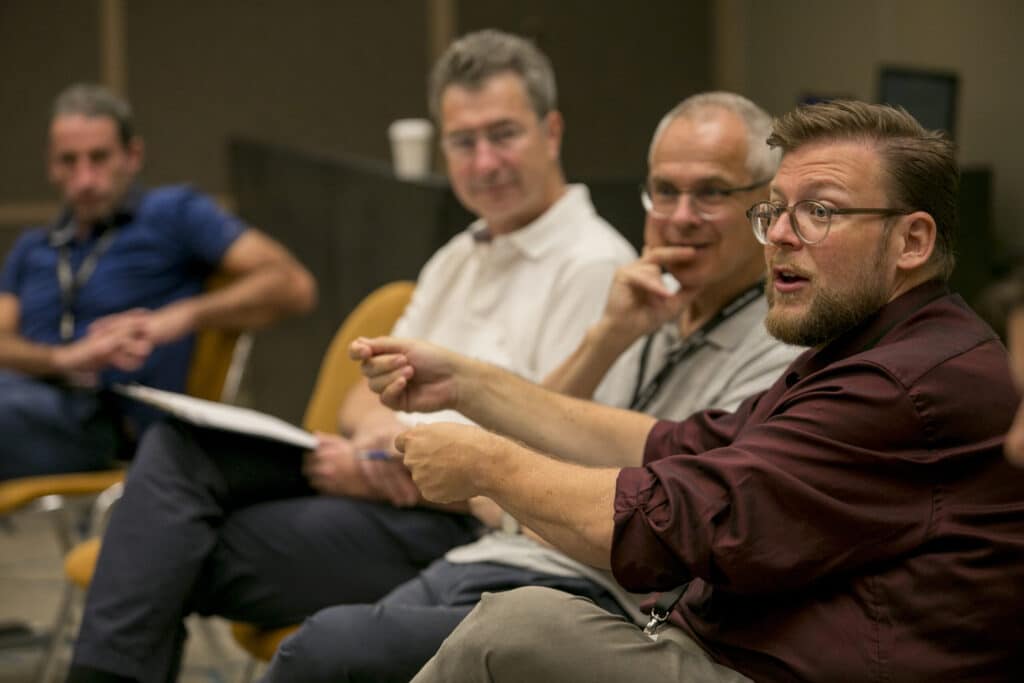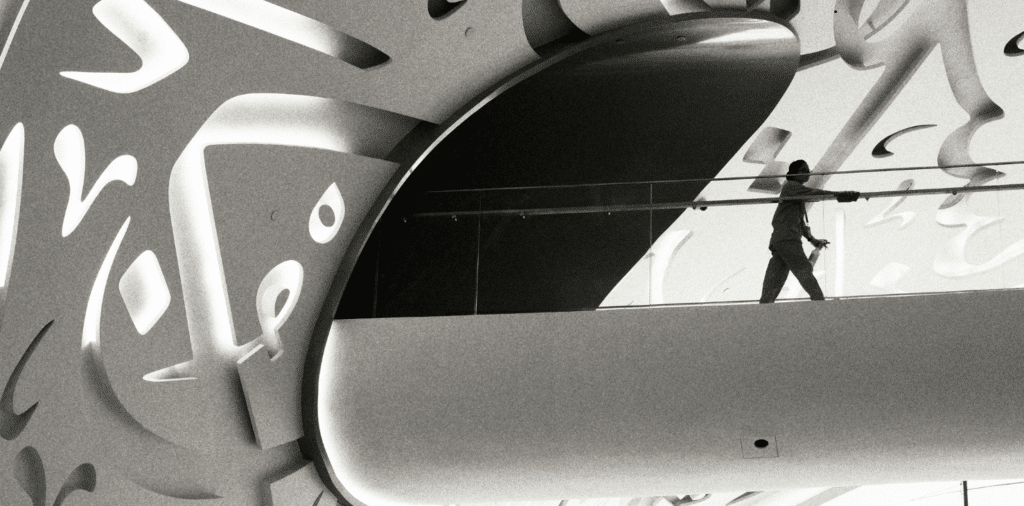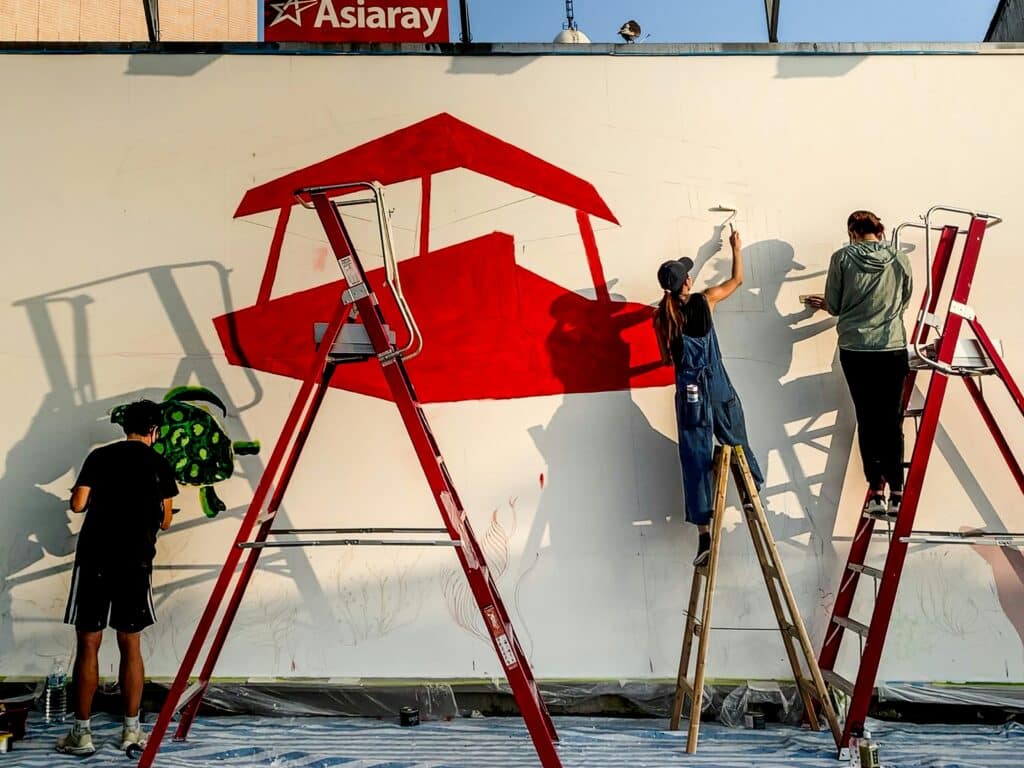The Crucial Role of the Facilitator in a Learning Experience

Written by Samuel Mueller
Recently, I facilitated a public learning experience in London called “Learning from the Unexpected,” which leveraged activities from our music-based Encore Leadership Experience. Some participants arrived a little bit late, and while we did have a buffer, our time for the opening segment was limited. I had already toyed with the idea of skipping my icebreaker question, “What music lyrics mean something to you?” because of the time pressure, but on a whim, I decided to keep it in.
There were a few participants who knew their lyrics well, but others were a bit more hesitant, maybe because they felt that what had popped up in their minds wasn’t as sophisticated. It took a little while until these more uncertain members of the group shared their lyrics, one of them being “Spice Up Your Life” by the Spice Girls and the other from “Baby Got Back” by Sir Mix-A-Lot. We laughed together, and while there was a bit of embarrassment at first, that vulnerability immediately lowered the threshold and created a safe place for learning and engagement.
Snap decisions, like this icebreaker, are a constant for facilitators in L&D. Creating the right tone and managing last minute challenges while connecting experiences to business objectives can sometimes feel like juggling chainsaws. Yet, when successful, facilitators can open the doors to authentic, human experiences that allow participants to engage with learning on so many more registers– not just cognitive and analytical, but also social and personal.
How do facilitators consistently create the right environment for learning? Personally, I think of attendees as something like actors in a play who need people behind the scenes, setting the stage and guiding them from one scene to the next. This is why facilitators are so important. I’m not the director or the actor. The stage is theirs, but I’m their stagehand or their assistant director that give cues while the participants act in their play. As they do the hard work of translating experiences to insights, I give them the time and space to actually foster that intellectual process.
I’d like to explore the crucial roles facilitators play during a learning experience. By diving deep into this process, you’ll gain the keys that turn passive audiences into active participants, applying themselves with grit and authenticity.
What is the job of a facilitator in a learning experience?
Your job as the facilitator is not to hand participants the answers on a silver platter. Your job is to set the scene, which gives people the keys to understand what they are doing and why. Experiential learning is great because it involves people physically, but it is not the same as an online course where I say, “Oh, you want to be ___? Here’s three skills that can get you there.” That’s a very linear process. What we do is very often anything but linear. The facilitator of a learning experience is a guide and a provocateur, who holds space for reflection. That reflection is what enables people to extract insights and, later, actions.
The Many Roles of the Facilitator in a Learning Experience
The Facilitator as Assistant Director
An important part of facilitating is assisting your participants as they make decisions and reach their desired outcomes. As a facilitator, ask yourself, “What am I trying to achieve?” Usually, you’ll think of tangible and intangible effects. An intangible effect, for example, could be trying to get people from Feeling A to Feeling B (from confusion to alignment, or maybe disconnected to inspired). Tangible effects might be to generate insights, create a manifesto, define a mission statement or invent a prototype, among other ideas.
Like an assistant director, you’re not controlling all of the choices. Because of this, it’s a good idea to get participants involved in the decision-making process early on. This is essential because, while the client may have a task or a mandate to fulfill, asking participants about their expectations puts them in the driver’s seat of both their learning and of whatever transformation comes out afterward. This approach helps attendees make themselves part of the story, which creates personal stakes in the learning experience.
At WDHB, we accomplish this by refraining from making everything about expectations, yet being a co-creator through bespoke Learning Expeditions. Participants can tell us what they consider success, but we raise the bar through instigating questions. This way, participants have the outside perspective they need to achieve a truly engaging experience.
“The moment you involve people is the moment they transform from passive audiences into active learners.”
Now, if your audience is still not involved, you need to ask yourself why. Is it that attendees don’t understand why they are there? Is the content not adequate for them? Are the questions not provocative enough? Whenever you face a new challenge, you need to analyze the root cause in order to solve it. For the facilitator, this self-reflection has to happen in real-time, while they are facilitating. That adds another high level of complexity and focus. However, the moment you involve people is the moment they transform from passive audiences into active learners.
The Facilitator Setting the Scene
Whenever we go into companies or meet exchange partners, we often ask the question, Do I brief them now? The timing can be tricky; sometimes you’re on the bus and you need to brief participants, but they are on their phones because people have just woken up in their usual time zones and now everybody’s calling them. When you’re walking up to a company, sometimes you have an opportunity to walk and talk. Will I interrupt them? Should I?
With the right timing, you can use these moments as a facilitator to actually step in and “set the scene” by framing conversation. It’s very important to set the scene well because, like great set design in a production, a strong sense of place and purpose helps everyone engage more effectively.
I prime people for an exchange by giving a detailed description of the company. What is this organization and what do they do? Who will participants meet? What should everyone expect in terms of an agenda? Sometimes, I’ll remind participants that this visit could connect to topics we discussed that morning, or offer questions that could act as follow-up and help steer conversation. In this way, moments like these can double as a debriefing.
As facilitator, I’m in charge of guiding the reflection and facilitating the exchange. By setting the scene (instead of handing participants the answers on a silver platter), you provide the keys to understanding how each new place connects to the larger objectives.
The Facilitator as Conductor
Not only do facilitators set the scene, but we also set the tone. While the conductor of an orchestra is a highly trained musician that doesn’t manage the intense level of change a facilitator does, both facilitators and conductors must set the tempo and strike the right chords together with a group. Doing so creates harmony and a sense of safety right from the start. And this tone must be established early on– sometimes even before the first debriefing.
Tone is important because, very often, our programs strike the hearts of individuals. We ask deep questions that go beyond the superficial, and that level of self-reflection can be a bit uncomfortable. In this highly sensitive process, we always want to create a safe space: the feeling that whatever is said will stay in the room and will be met with appreciation, not judgment.
Depending on participants, their personalities, backgrounds and organizational cultures, creating a safe space can happen naturally or require a little push. While we as facilitators need to be recognized as legitimate and have a certain authority to speak on these topics, participants don’t always know us or trust us yet. I mean, it’s a bit scary if suddenly there’s this individual in front of you that needs you to speak on relatively personal matters!
Sharing some of your work experiences can help you to earn trust. If people understand that you’ve facilitated a program like this a few times before or that you’ve had relevant experiences, they will want to open up more. Also helpful is when participants see that you’re not judging– which is not always easy. I’m always learning as a facilitator, and I’ve had my fair share of mess-ups when earning or breaking trust. I’m constantly improving my social awareness: that ability to read an audience and react to someone’s implicit or explicit needs. Ultimately, if you can let people feel your experience, feel your own open-mindedness, you can successfully build up that trust and hold that safe space.

The Future of L&D
Discover post-pandemic workplace dynamics, AI’s impact on Learning & Development and how L&D can nurture learning communities.
The Facilitator As Stage Manager
We all know the saying: The show must go on. Learning experiences are live, so we don’t always know what will happen. Like a stage manager in the background keeping a show running against all odds, the facilitator must also stay cool, calm and in control when adverse situations arise.
I think adapting on the spot is all about being honest, transparent and positive. If needed, you can acknowledge with participants that something didn’t go according to plan. Sometimes, you can use the situation as a teachable moment. It’s especially beautiful when participants are the ones who take an imperfect moment and immediately unearth learnings. Some of the best experiences have been when participants asked on their own, “Hey, what does this moment say about us? How would we have handled that situation? How would we have shown up in that exchange if someone had asked us to do this?”
I remember one workshop in particular that we had to abort. We were discussing organizational dynamics through a playful workshop given by an expert on the topic. However, that morning she and her co-facilitator had lost a good friend. They decided to still run the workshop, but with only one facilitator while the other went to the funeral. The workshop ended up being terrible. The content expert was not at her best and the participants were not at all engaged. The participants themselves, in a very graceful way, said, “You know, it was maybe not the right decision to go forward with this workshop under these circumstances. Maybe it’s best that we complete it here.” And then we left.
The team and I were quite touched (and a little disturbed), but the participants weren’t at all upset. They consoled us and said, “Hey guys, seeing this was a great lesson for us. We recognized and responded to the situation as a team, knowing that this was the right choice.”
It’s quite beautiful when things work out that way. And of course, sometimes you’re dealing with problems that will never see the light of day. It’s like the duck, paddling furiously underwater while you are calm and collected on the surface.
Conclusion
Experiential learning, I think, is very rooted in authenticity. Just through the rawness of honest stories, meaningful connections and unexpected destinations, these lessons arrive unfiltered and completely human, with no shiny coating. While there are many roles for you to balance as a facilitator, it’s important to remember that progress mainly comes from courage and tenacity, not just from genius. You don’t have to have the perfect system, nor is there a perfect system. Half of the gamble is just doing it, rolling with changes as they arrive, and creating the right atmosphere for the convergence of new ideas. With time and transparency, you’ll guide moments in learning that are spontaneous, engaging and unforgettable.
Author
Subscribe to get Access to Exclusive Content





